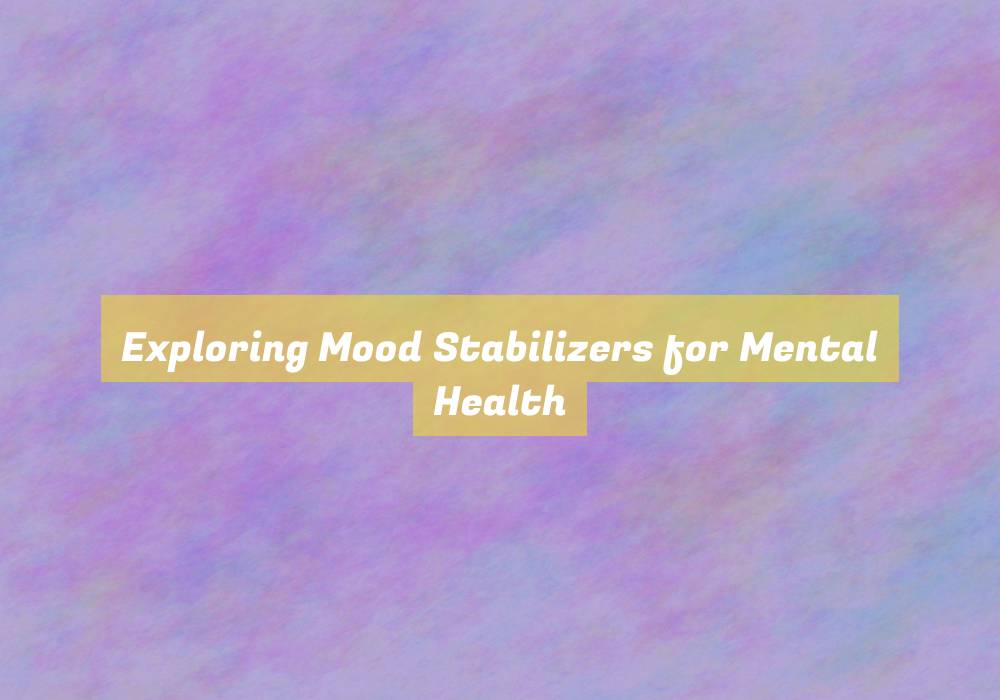Exploring Mood Stabilizers for Mental Health
Imagine a ship navigating through turbulent waters, constantly adjusting its course to maintain stability. Just like the ship, your mind may encounter stormy seas, and mood stabilizers could serve as your compass.
Understanding the different types of mood stabilizers, their mechanisms of action, potential side effects, and the latest research and developments can be crucial in managing mental health conditions.
As you explore this topic, youG??ll uncover the intricate ways in which these medications work to help individuals find balance in their emotional well-being.
Types of Mood Stabilizers
When considering types of mood stabilizers, itG??s important to understand that they can be categorized into different classes based on their mechanism of action and chemical structure.
The first class includes lithium, which is one of the oldest and most commonly used mood stabilizers. ItG??s believed to help reduce the severity and frequency of manic episodes.
Anticonvulsants make up the second class of mood stabilizers. Medications like valproic acid and lamotrigine fall into this category and are often used to treat bipolar disorder by stabilizing mood fluctuations.
Additionally, atypical antipsychotics form another class of mood stabilizers. Drugs like aripiprazole and olanzapine are utilized to manage symptoms of bipolar disorder by regulating neurotransmitters in the brain.
Each class of mood stabilizers works through different mechanisms to achieve the common goal of stabilizing mood and preventing extreme fluctuations.
Understanding the distinctions between these classes can help individuals and healthcare providers make informed decisions about the most suitable treatment options.
Mechanisms of Action
Understanding how mood stabilizers work can provide valuable insight into their effectiveness in managing mental health conditions.
The mechanisms of action for mood stabilizers arenG??t fully understood, but theyG??re thought to modulate neurotransmitters in the brain, such as serotonin, dopamine, and norepinephrine. For example, lithium, a common mood stabilizer, is believed to impact the activity of these neurotransmitters, which play a crucial role in regulating mood, emotion, and behavior. This modulation may help stabilize the extreme highs and lows associated with bipolar disorder.
Additionally, anticonvulsant mood stabilizers like valproate and carbamazepine may work by increasing the activity of the neurotransmitter gamma-aminobutyric acid (GABA), which has a calming effect on the brain.
Another potential mechanism of action for mood stabilizers involves the regulation of intracellular signaling pathways and gene expression. Research suggests that mood stabilizers may influence the expression of certain genes involved in mood regulation and neuronal function. By targeting these pathways, mood stabilizers could exert their therapeutic effects on mood disorders.
Understanding these mechanisms of action can provide valuable insights into the development of more effective treatments for individuals with mood disorders.
Potential Side Effects
You may experience potential side effects when taking mood stabilizers for managing mental health conditions. These medications are generally well-tolerated, but like any medication, they can cause adverse reactions in some individuals.
Common side effects of mood stabilizers include: – Drowsiness – Dizziness – Nausea – Vomiting – Diarrhea – Changes in appetite or weight
You may also notice: – Tremors – Increased thirst – Frequent urination
In some cases, mood stabilizers can lead to: – Hair loss – Skin rashes – Sensitivity to sunlight
ItG??s important to be aware of the potential for mood stabilizers to affect thyroid function, leading to symptoms such as: – Fatigue – Cold intolerance – Weight gain
Additionally, some individuals may experience cognitive side effects, such as: – Memory problems – Difficulty concentrating
Less frequently, mood stabilizers can affect liver function, so itG??s important to monitor for signs of: – Jaundice – Dark urine – Persistent abdominal pain
If you notice any concerning symptoms while taking mood stabilizers, itG??s crucial to consult your healthcare provider promptly.
Latest Research and Developments
As mood stabilizers continue to be studied and refined, recent research and developments have focused on minimizing potential side effects and enhancing their effectiveness in managing mental health conditions. One area of advancement is the development of new formulations that aim to reduce the risk of common side effects such as weight gain, sedation, and cognitive impairment. Researchers are also investigating the use of pharmacogenetic testing to personalize treatment plans, allowing for more tailored and effective use of mood stabilizers based on an individualG??s genetic makeup.
Furthermore, thereG??s a growing interest in exploring the potential of novel drug targets and mechanisms of action to improve the overall efficacy of mood stabilizers. This includes investigating the role of inflammatory pathways, neuroplasticity, and circadian rhythms in the development of mood stabilizing medications. Additionally, ongoing clinical trials are evaluating the effectiveness of combination therapies and adjunctive treatments to optimize outcomes for individuals with mood disorders.
In the realm of technology, digital health interventions and smartphone applications are being integrated into treatment plans to monitor medication adherence, mood symptoms, and overall mental well-being. These innovative approaches aim to provide more comprehensive support for individuals using mood stabilizers, ultimately contributing to better management of mental health conditions.
Conclusion
Overall, mood stabilizers are an important treatment option for managing mental health conditions such as bipolar disorder. They work by targeting the underlying mechanisms of mood dysregulation and can help individuals maintain stability and improve their overall quality of life.
While they may come with potential side effects, ongoing research and developments are paving the way for more effective and tolerable options in the future.







Your analogy of the ship navigating turbulent waters really resonates with me. It’s true that just like a sailor relies on a compass, individuals dealing with mood disorders often rely on mood stabilizers to help steer through the ups and downs of life. I’ve seen firsthand how effective medications like lithium can be, both in my own life and in the lives of friends who have grappled with bipolar disorder.